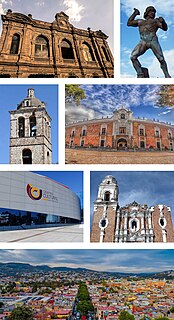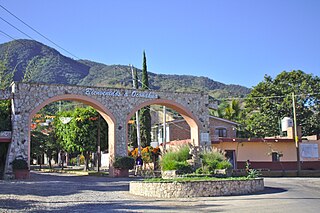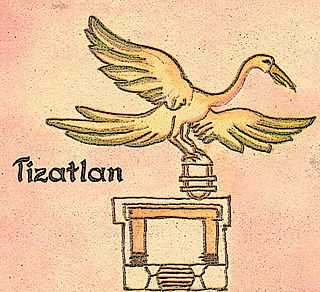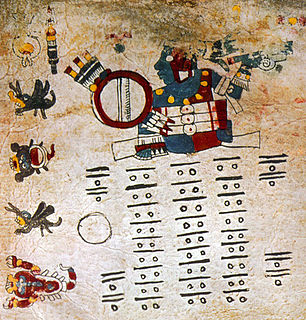
Ocotelolco (sometimes spelled Ocotelulco), in pre-Columbian Mexico, was one of the four independent altepetl (polities) that constituted the confederation of Tlaxcallan. The site is in the present day state of Tlaxcala in central Mexico.

Ocotelolco (sometimes spelled Ocotelulco), in pre-Columbian Mexico, was one of the four independent altepetl (polities) that constituted the confederation of Tlaxcallan. The site is in the present day state of Tlaxcala in central Mexico.
Ocotelolco was the second of the four altepetl to be founded. At the time of the Spanish conquest of Mexico it was, along with Tizatlan, the most powerful of the four allied communities. Where Ocotelolco held the economical power, having the main market in the region, Tizatlan had the military power and commanded the Tlaxcallan armies.
When the Spanish arrived in Mexico Ocotelolco was ruled by Maxixcatzin. Through a series of political events Ocotelolco finally achieved dominance over Tizatlan at the end of the conquest.
Excavations at the site in 1990-1991 carried out by the Instituto Nacional de Antropología (INAH) exposed a room with a painted altar and bench (47 cm high extending 8 meters along the room's north wall). [1] The painted frieze closely resembles the Codex Borgia in style. The bench features a series of alternating skulls, human hearts, hands, and shields while eight anthropomorphic serpents descend on three sides of the altar, surrounding a central image of a deity (identified as Tezcatlipoca) surrounded by a frame of flint knives, similar in its composition to the image on plate 32 of the Codex Borgia. [2] [3]

The Aztecs were a Mesoamerican culture that flourished in central Mexico in the post-classic period from 1300 to 1521. The Aztec peoples included different ethnic groups of central Mexico, particularly those groups who spoke the Nahuatl language and who dominated large parts of Mesoamerica from the 14th to the 16th centuries. Aztec culture was organized into city-states (altepetl), some of which joined to form alliances, political confederations, or empires. The Aztec Empire was a confederation of three city-states established in 1427: Tenochtitlan, city-state of the Mexica or Tenochca; Texcoco; and Tlacopan, previously part of the Tepanec empire, whose dominant power was Azcapotzalco. Although the term Aztecs is often narrowly restricted to the Mexica of Tenochtitlan, it is also broadly used to refer to Nahua polities or peoples of central Mexico in the prehispanic era, as well as the Spanish colonial era (1521–1821). The definitions of Aztec and Aztecs have long been the topic of scholarly discussion ever since German scientist Alexander von Humboldt established its common usage in the early nineteenth century.

Tlaxcala, officially Tlaxcala de Xicohténcatl, is the capital city of the Mexican state of Tlaxcala and seat of the municipality of the same name. The city did not exist during the pre Hispanic period but was laid out by the Spanish as a center of evangelization and governance after the Spanish conquest of the Aztec Empire. It was designated as a diocese but eventually lost this status to Puebla as its population declined. The city still has many of its old colonial structures including the former Franciscan monastery, as well as newer civic structures such as the Xicohtencatl Theatre.

Tlaxcala, officially the Free and Sovereign State of Tlaxcala, is one of the 32 states which comprise the Federal Entities of Mexico. It is divided into 60 municipalities and its capital city is Tlaxcala.
The Tlaxcalans, or Tlaxcaltecs, are a Nahua people who live in the Mexican state of Tlaxcala.

Aztec society was a highly complex and stratified society that developed among the Aztecs of central Mexico in the centuries prior to the Spanish conquest of Mexico, and which was built on the cultural foundations of the larger region of Mesoamerica. Politically, the society was organized into independent city-states, called altepetls, composed of smaller divisions (calpulli), which were again usually composed of one or more extended kinship groups. Socially, the society depended on a rather strict division between nobles and free commoners, both of which were themselves divided into elaborate hierarchies of social status, responsibilities, and power. Economically the society was dependent on agriculture, and also to a large extent on warfare. Other economically important factors were commerce, long-distance and local, and a high degree of trade specialization.

Aztec codices are Mesoamerican manuscripts made by the pre-Columbian Aztec, and their Nahuatl-speaking descendants during the colonial period in Mexico.

The Spanish conquest of the Aztec Empire, also known as the Conquest of Mexico or the Spanish-Aztec War (1519–21), was one of the primary events in the Spanish colonization of the Americas. There are multiple 16th-century narratives of the events by Spanish conquistadors, their indigenous allies, and the defeated Aztecs. It was not solely a contest between a small contingent of Spaniards defeating the Aztec Empire but rather the creation of a coalition of Spanish invaders with tributaries to the Aztecs, and most especially the Aztecs' indigenous enemies and rivals. They combined forces to defeat the Mexica of Tenochtitlan over a two-year period. For the Spanish, the expedition to Mexico was part of a project of Spanish colonization of the New World after twenty-five years of permanent Spanish settlement and further exploration in the Caribbean.

Oconahua is a small town in the Mexican state of Jalisco. It has some 2,000 inhabitants. It is a Delegation of the municipality of Etzatlán.

The traditions of indigenous Mesoamerican literature extend back to the oldest-attested forms of early writing in the Mesoamerican region, which date from around the mid-1st millennium BCE. Many of the pre-Columbian cultures of Mesoamerica are known to have been literate societies, who produced a number of Mesoamerican writing systems of varying degrees of complexity and completeness. Mesoamerican writing systems arose independently from other writing systems in the world, and their development represents one of the very few such origins in the history of writing. The conquistadors brought their distinctive cultural creations, in the form of books, from Europe to the New World which further influenced native literature.

Tlaxcala was a pre-Columbian city and state in central Mexico.

Cholula was an important city of pre-Columbian Mesoamerica, dating back to at least the 2nd century BCE, with settlement as a village going back at least some thousand years earlier. The site of Cholula is just west of the modern city of Puebla and served as a trading outpost. Its immense pyramid is the largest such structure in the Americas, and the largest pyramid structure by volume in the world.

Xicotencatl I or Xicotencatl the Elder was a long-lived tlatoani (king) of Tizatlan, a Nahua altepetl within the pre-Columbian confederacy of Tlaxcala, in what is now Mexico.
Arthur James Outram Anderson was an American anthropologist specializing in Aztec culture and translator of the Nahuatl language.

Maxixcatl was the tlatoani (ruler) of the Nahua altepetl (city-state) of Ocotelolco at the time of the Spanish conquest of Mexico.
Xicotencatl II Axayacatl, also known as Xicotencatl the Younger, was a prince and warleader, probably with the title of Tlacochcalcatl, of the pre-Columbian state of Tlaxcallan at the time of the Spanish conquest of Mexico.

Tizatlan, in pre-Columbian Mexico, was one of the four independent altepemeh that constituted the confederation of Tlaxcallan. Today Tizatlan is a part of the modern city of Tlaxcala, and the Pre-Columbian city is visible as a small archaeological site. The site is in the state of Tlaxcala in central Mexico.

The Codex Cospi is a pre-Columbian Mesoamerican pictorial manuscript, included in the Borgia Group. It is currently located in the library of the University of Bologna.

San Esteban de Nueva Tlaxcala was a Tlaxcalan municipality in what is now the Mexican state of Coahuila. San Esteban was the northernmost of the six Tlaxcalan colonies established in 1591 at the behest of the Viceroy of New Spain, Luis de Velasco; its founders came from Tizatlan. In 1834, San Esteban was merged into the adjoining city of Saltillo.

Ahuiyateteo [awiyateteo] or Macuiltonalehqueh [makʷiɬtonaleke] were a group of five Aztec gods of excess and pleasure. They also represented the dangers that come along with these. These five gods were also invoked by diviners and mystics. They were associated with the Tzitzimimeh, a group of frightening beings that personified death, drought, and war.

Mesoamerican codices are manuscripts that present traits of the Mesoamerican indigenous pictoric tradition, either in content, style, or in regards to their symbolic conventions. The unambiguous presence of Mesoamerican writing systems in some of these documents is also an important, but not defining, characteristic, for Mesoamerican codices can comprise pure pictorials, native cartographies with no traces of glyphs on them, or colonial alphabetic texts with indigenous illustrations. Perhaps the best-known examples among such documents are Aztec Codices, Maya Codices, and Mixtec Codices, but other cultures such as the Tlaxcaltec, the Purepecha, the Otomi, the Zapotec, and the Cuicatec, are creators of equally relevant manuscripts.
| Wikimedia Commons has media related to Ocotelulco . |